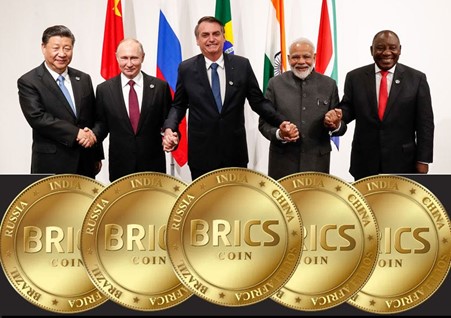
The BRICS alliance, initially formed in 2006 by Brazil, Russia, India, China, and South Africa, has experienced a transformative expansion in 2024. The BRICS grouping collectively occupies considerable economic power in the globe. The expansion of BRICS membership has further boosted its influence. The group represents a significant portion of the world’s population, Gross Domestic Product (GDP), global trade, and energy production. In 2023, Brazil’s President called on the BRICS nations to create a common currency for trade and investment between each other, as a means of reducing their dependability on vulnerable American dollar exchange due to rate fluctuations.
Officials and economists have pointed out the difficulties involved in such a project, given the economic, political, and geographic discrepancies between Brazil, Russia, India, China, and South Africa. Brazil’s president doesn’t believe nations that don’t use the dollar should be forced to trade in the currency, and he has also backed for a common currency in the Mercosur block of South American countries. The Southern Common Market, commonly known by Spanish abbreviation Mercosur, and Portuguese Mercosur, is a South American trade bloc established by the Treaty of Asunción in 1991 and Protocol of Ouro Preto in 1994. Its full members are Argentina, Brazil, Paraguay, and Uruguay. Right now, it’s an assumption that BRICS currency will increase payment options and reduce the vulnerabilities, of currency fluctuation.
What other BRICS leaders think? South African officials said a BRICS currency was not there on their agenda. Building a BRICS currency would be a “tough political project”, South African central bank governor announced in July 2023. He said that for getting BRICS currency they will need a banking union, a fiscal union, to some extent they will need macroeconomic merging of the BRICS nations. A lot of disciplined mechanism will be required for the countries that fall out of line with it. Most importantly, they will need a common central bank, in which country could it be located? Trade imbalances cannot be ignored. All BRICS member countries have China as their main trading partner and little trade with each other.
The potential benefits of a BRICS currency include reducing dependence on the US dollar and increasing economic cooperation among member countries. The potential benefits of a BRICS currency include a dominance in international trade and a preference from 58% of countries.
BRICS leaders have said they want to use their national currencies more instead of the dollar, which strengthened sharply last year as the Federal Reserve raised interest rates and Russia invaded Ukraine, making dollar debt and many imports more expensive. Russia’s sanctions-imposed expulsion from global financial systems last year also fuelled speculation that non-western allies would shift away from the dollar.
Last year’s BRICS summit was a tricky assignment for Indian Prime Minister Narendra Modi, who aimed to tackle several thorny issues: balancing India’s ties with Russia and the West, managing BRICS expansion, and addressing border tensions with China. Modi tackled these issues plus some more upcoming bilateral trade problems gracefully.
India has a strong voice in the BRICS and the UN, India spoke out against policies or actions that may harm the interests of any member. For example, India turned down China’s request to allow Pakistan, Sri Lanka, and Mexico to join the BRICS.
Coming back to the issue of BRICS currency: each of the BRICS countries supports the currency initiative for different reasons. Russia and China are at the forefront of the de-dollarisation move for their political interests. Russia is trying to avoid US sanctions by challenging the dollar-dominated financial system, while China is promoting the Renminbi (official currency of the People’s Republic of China) as an alternative. Since more than 17 percent of its reserves are in Renminbi, Russia has a greater preference for transacting in Renminbi. On the other hand, India, South Africa, and Brazil have their own pragmatic reasons for supporting the move. Reduced dollar dominance in international transactions will make it easier for these nations facing a dollar crunch to repay their debts owed to international organisations. A 2019 study by Global Business Review compared the regime-switching behaviour of the real exchange rates of the five BRICS nations before and after the group’s formation. It concluded that the inclusion of a stronger policy interaction in the region, especially in monetary management, shows the chance of a strong currency union amongst BRICS members.
From 1st Jan 2024, Saudi Arabia, Iran, the United Arab Emirates, Ethiopia, and Egypt have announced to join BRICKS block. The expansion of BRICS will diminish South Africa’s significance even further because the two African states joining, Egypt and Ethiopia, are both more populous than South Africa and are experiencing higher rates of economic growth, though in much smaller economies.
More than 40 countries have expressed interest in joining, the question of whether BRICS would admit new members was finally answered during a recent group’s summit. Despite pre-summit reports of division over the potential expansion, leaders from the five-nation bloc announced that Saudi Arabia, Iran, Ethiopia, Egypt, Argentina, and the United Arab Emirates (UAE) would join the group starting in 2024. Argentina was invited to join but declined the invitation.
With the addition of these six countries, BRICS now represents 42 percent of the world’s population and 36 percent of global GDP. The primarily economic bloc was originally created as an alternative to the U.S.-led international order, with the goal of offering growing countries in the Global South a to counterbalance the Western institutions.
Conclusion
The potential impact of a new BRICS currency on the US dollar remains uncertain, experts are debating its potential to challenge the dollar’s dominance. However, if a new BRICS currency was to stabilize against the dollar, it could weaken the power of US sanctions, leading to a further decline in the dollar’s value.













































